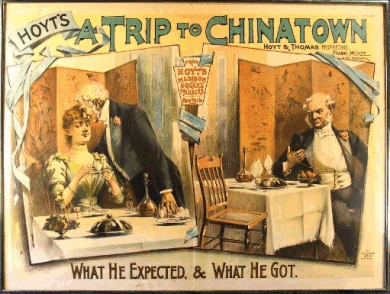The Bowery
Words by Percy Gaunt; music by Charles H. Hoyt, 1891 |

 |
What seems to be happening in this song? Who is telling the story? "The Bowery" here is a real section of New York (in fact Bowery merchants protested that this song gave their neighborhood a bad reputation!). What has the term "bowery" or "Bowery district" come to mean? |
 |
Though this song is humorous, it has a more serious underlying message. What do you think the message is? What lines summarize the message? |
 |
This song is one of many during this era telling the story of young people visiting or moving to the city and getting into trouble. Why do you think this was a popular theme for early Tin Pan Alley songs? This era saw unprecedented growth of cities and migration from rural to urban areas to take advantage of new job opportunities in growing industries. |
 |
What worries did people have about unfamiliar city life? What rumors did they probably hear? What real problems did they likely encounter when making the move? How do you think families were affected when sons and daughters moved away from farms to jobs in the cities? |
|

"The Bowery" performed by Richard Perry on I Wants to Be a Actor Lady and Other Hits from Early Musical Comedies, New World Records, © 1978. Available on iTunes, Spotify, and YouTube.
On this recording from 1978, the arranger, Ronald Burnside, uses a variety of instruments and the singer, Richard Perry, uses dramatic voicing to recreate how this song would have originally sounded in theaters of the 1890s. The diverse percussion instruments keep the waltz rhythm that is characteristic of many popular songs of this era. The different woodwind, brass, and string instruments accompany the melody. |

View the lyrics for "The Bowery."
View the published score. |
|

"The Bowery" is a tune from a successful 1891 musical, A Trip to Chinatown. After a night on the town in San Francisco, the main character remarks that it reminds him of his first night in New York City and regales his companions with the details in "The Bowery." Bowery merchants protested that the song maligned them, but the piece nevertheless became such a big hit that it made the show itself a hit.
The song was a favorite of tourists and cultural visitors to New York, who then went to see what all the talk of the Bowery was about. It symbolized for them the depravity of the largest urban area on the continent. The dangers to the unsuspecting visitor from other smaller cities or rural areas was understood by listeners throughout the country, who found their young people moving to the cities in unprecedented numbers to find work in factories, offices, and service industries.
Poster for A Trip to Chinatown, 1891. |
 Write and design a guide book for young people moving from the country to a city in the 1880s or 1890s. Use a real city near you, so you can find primary and secondary sources at nearby libraries and museums to make your guide as authentic as possible. Include maps, illustrations, and photos to help your reader know what to expect and how to avoid getting into trouble. Write and design a guide book for young people moving from the country to a city in the 1880s or 1890s. Use a real city near you, so you can find primary and secondary sources at nearby libraries and museums to make your guide as authentic as possible. Include maps, illustrations, and photos to help your reader know what to expect and how to avoid getting into trouble.
|

Bowery or bowery district: A street and area of lower Manhattan noted for its places of cheap amusement and homeless vagrants.
yap: Fool. |

Compare this song to:
"Father's a Drunkard, and Mother is Dead" (in this unit)
"How Ya Gonna Keep Him Down on the Farm?" (Unit 6) |
|


